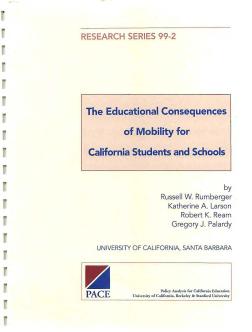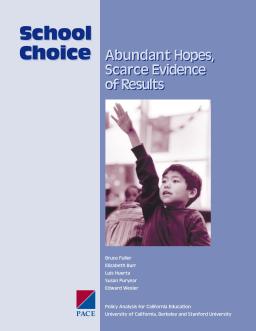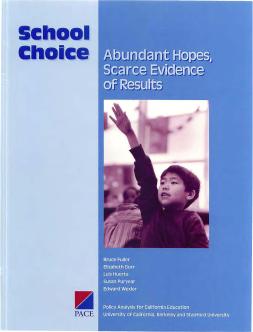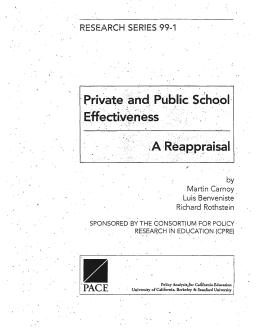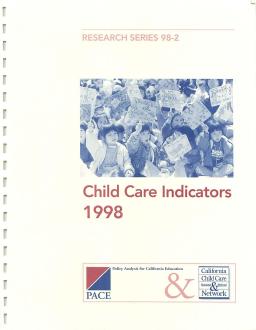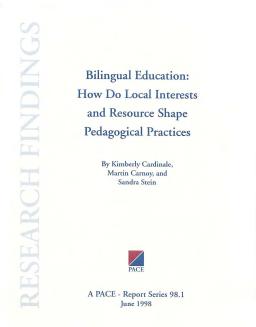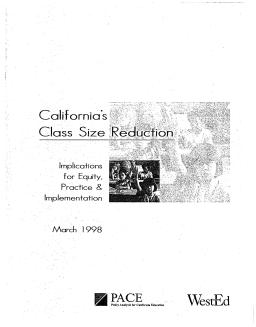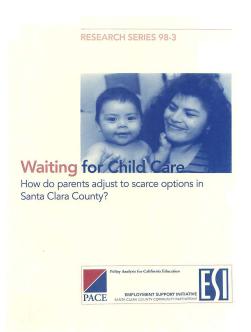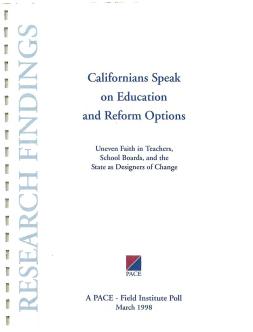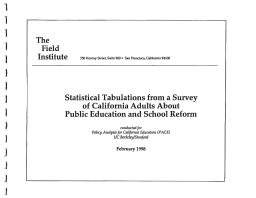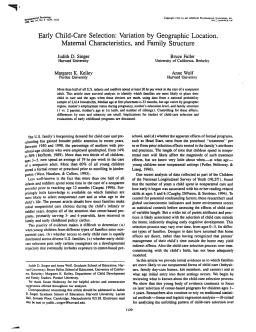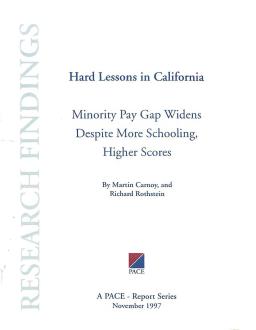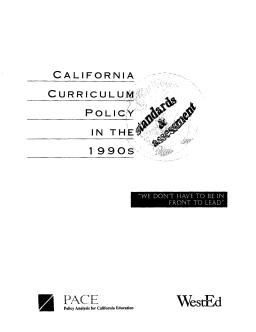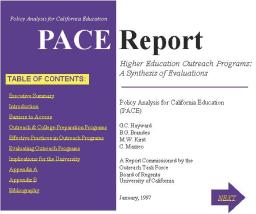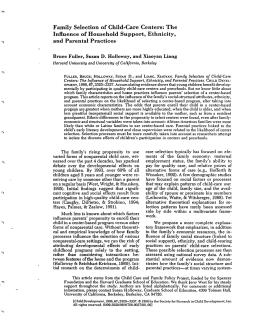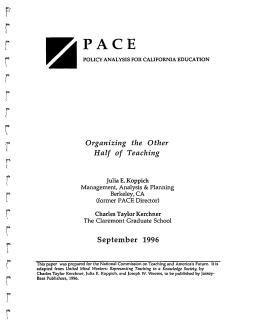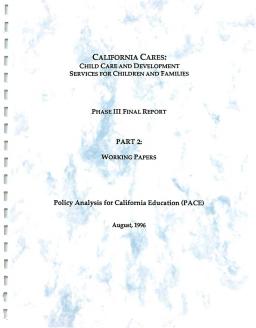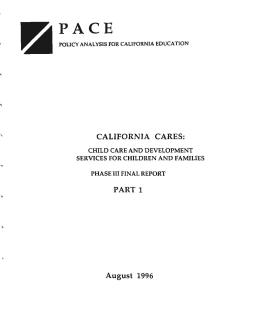Published
Summary
This study examines student mobility in California, particularly at the secondary level. It investigates the incidence, consequences, and causes of non-promotional school changes and offers strategies to address the issue. It also draws on an extensive dataset from various sources, including surveys and interviews with California students, parents, and schools. The findings highlight the negative impact of student mobility on educational achievement and suggest that families, schools, community agencies, and policymakers should take action to mitigate its harmful effects.
Published
Summary
Student mobility, or non-promotional school changes, is a widespread problem that harms students' educational achievement. This report examines the incidence, consequences, and causes of mobility among California students and schools, drawing on surveys of students, parents, and schools, interviews with mobile students and their parents, and interviews with school administrators, counselors, and teachers. The report summarizes the findings on the causes and consequences of mobility and offers strategies for reducing needless mobility and mitigating its harmful effects.
Published
Summary
Spring 1999 PACE Newsletter, Volume 2, Number 1. This newsletter from Policy Analysis for California Education (PACE) addresses several key topics related to education policy in California, including school choice, student mobility, welfare reform and child care, affirmative action in university admissions, and education reforms under Governor Pete Wilson. The school choice movement is growing across California and the United States, with various alternatives to traditional public schools including vouchers, charter schools, tax credits, magnet schools, and open enrollment. Despite political...
Abundant Hopes, Scarce Evidence of Results—Executive Summary
Published
Summary
Public education in the US is widely criticized and everyone wants to reform it, but there's no consensus on the best strategy for improvement. This report focuses on school choice, a reform avenue gaining steam in California and the US, to explore policies and institutional changes that can boost children's learning.
Published
Summary
The report provides local and state-level policymakers with data on the current capacity of the childcare system and indicators of future growth in family demand. It includes county-level aggregates, new data on job-related income, and estimates for families earning less than 75% of California's median income. It also adds new data on the size of the childcare workforce in each county, revealing disparities in the availability of childcare services and the number of local residents depending on the industry for their livelihood.
Abundant Hopes, Scarce Evidence of Results
Published
Summary
Public education receives criticism from various stakeholders. Despite satisfaction with local elementary schools, overall quality concerns prevail. There is no consensus on the best approach to improve schools. PACE report investigates school choice, which is a reform strategy gaining popularity in California and beyond.
A Reappraisal
Published
Summary
This report challenges the belief that public schools are ineffective due to a lack of accountability for producing high academic achievement. Some argue that private management is necessary for improvement, but this report seeks to analyze the range of responses that schools have to accountability and determine whether market forces are necessary for improvement.
Preliminary Figures
Published
Summary
California's childcare system lacks planning capacity and data on supply and demand. The Child Care Indicators 1998 report provides early indicators of supply and demand for all zip codes statewide, but zip codes may not reflect local residents' own definition of their community. Public funding for childcare and preschool programs will double in California between 1996 and 1999, but targeting new funding to areas with the greatest need remains a challenge.
How Do Local Interests and Resources Shape Pedagogical Practices?
Published
Summary
Bilingual education implementation varies by district due to discourse and policies. Four issues affecting implementation are teacher recruitment, "ghettoization" of bilingual education, race relations, and community consensus. National debates impact local administrative actions, defining bilingual education practice. The report analyzed four California school districts to show the impact of these four issues on program design.
A Study of Eight States and the District of Columbia
Published
Summary
This report presents the results of a study investigating the impact of charter schools on school districts, how they responded, and whether they experienced systemic change due to charter laws. The study focused on eight US states and the District of Columbia and included case studies of 25 affected school districts. The research was funded by The Saint Paul Foundation and conducted in 1997, six years into the charter school experiment. PACE hosted the study.
Implications for Equity, Practice, and Implementation
Published
Summary
In 1996, CA launched a $1 billion class size reduction (CSR) initiative to improve early literacy. The initiative provides $800 per student to schools reducing class size to 20 or fewer in first, second, and/or third grade, and kindergarten. CSR was funded due to a state revenue surplus and the belief that smaller classes would enhance early literacy. CA ranked second to last in national reading tests in 1994, and class sizes averaged around 28.6 students per K-3 classroom. While educators and the public show enthusiasm, the success of CSR in enhancing academic achievement is yet to be seen.
How Do Parents Adjust to Scarce Options in Santa Clara County?
Published
Summary
In 1998, the PACE research center surveyed low-income and blue-collar parents to help streamline the process of finding childcare, in response to the state's welfare reform legislation. The survey included 300 in-depth interviews and covered topics such as employment, searching for childcare, interim childcare, and perceptions of care quality. The report addresses the policy problem and how parents perceive their limited childcare options.
Uneven Faith in Teachers, School Boards, and the State as Designers of Change
Published
Summary
Public education quality has long been debated, worrying parents, activists, and politicians. Recent polls show it is a top concern in California and the US. Politicians and activists propose school reform, and a new election season has begun. PACE and the Field Institute surveyed 1,003 Californians in February to assess their views on education quality, trusted reformers, and evaluating major proposals. The report details key findings.
Published
Summary
This volume presents the results of a PACE survey conducted by The Field Institute among 1,003 California adults via random digit dialing. Statistical weights were developed to match the sample of California adults interviewed to known parameters of the adult population. Estimates of sampling error from results based on the overall adult public sample are +/- 3 percentage points. Other possible sources of error include differences in question wording, sequencing, or undetected errors or omissions in sampling, interviewing, or data processing. The study professionals minimized such errors.
Variation by Geographic Location, Maternal Characteristics, and Family Structure
Published
Summary
This article uses survival analysis to examine factors associated with placing infants and toddlers in nonparental care, and at what ages. Using data from a national probability sample of 2,614 households, the study finds that the median age at first placement is 33 months and varies by geographic region, mother's employment status during pregnancy, education level, and family structure. Differences by race and ethnicity are small. The article discusses implications for studies of childcare selection and evaluations of early childhood programs.
California Families Face Gaps in Preschool and Child Care Availability
Published
Summary
This report highlights the unequal distribution of preschool and childcare opportunities in California. Despite spending $1.2 billion annually, half of preschool-age children live in households with working mothers, with enrollment dependent on income and location. Counties vary greatly in their supply, with affluent parents more likely to find preschool or childcare slots. Latino children are hit hardest, even in counties with ample supply, with supply in predominantly Latino areas half that of low-income Black or Anglo communities.
Minority Pay Gap Widens Despite More Schooling, Higher Scores
Published
Summary
African Americans and Latinos historically have lower educational attainment, achievement, and wages compared to whites. Narrowing education gaps between minorities and whites should narrow wage gaps. This report analyzes whether California's education gap improvement between minorities and whites led to a parallel reduction in wage gaps. The report finds that the educational attainment and achievement of California's minority youth improved significantly from the 1970s to 1988.
A Challenge for the New PACE
Published
Summary
Fall 1997 PACE Newsletter Volume 1 Number 1 This inaugural newsletter from Policy Analysis for California Education (PACE) covers a wide range of education policy issues affecting California’s K–12 system, including class size reduction, charter schools, standards-based reform, higher education outreach, and child care policy. Class size reduction is a major focus, with discussions on California’s $1.5 billion Class Size Reduction (CSR) initiative aimed at improving educational outcomes by limiting K–3 classes to 20 or fewer students. Enthusiasm among educators for smaller classes is high, but...
Standards and Assessments
Published
Summary
This study traces California's curriculum-related reforms in mathematics and science during the 1990s, examining the role of the California Department of Education and the state's shifting political and policy context. It analyzes the perceptions of state officials, experts, and the public and how they influenced state policy changes. The authors raise questions about problems associated with curriculum policy in California and presents policy recommendations mentioned during interviews and document analysis. The study does not assess the impact of curriculum on school practice.
A Synthesis of Evaluations
Published
Summary
The PACE report commissioned by the University of California aims to enhance university participation by disadvantaged and underrepresented students. It reviews evaluations of current outreach programs, identifies effective practices, and makes recommendations for program improvement and evaluation methods. The report analyzes the effectiveness of college preparation programs and suggests essential principles for program design. It also examines how to improve evaluations of outreach programs and the implications for policy decisions on future outreach efforts.
The Influence of Household Support, Ethnicity, and Parental Practices
Published
Summary
An investigation of the family factors and practices that influence parents' choice of center-based programs for young children. Maternal education, child's age, and availability of social support were found to be significant factors in center selection. African-American families were more likely to choose center-based care than white or Latino families, and parental practices related to early literacy development and close supervision also affected center selection. The study highlights the importance of considering selection processes when assessing the effects of early childhood programs.
1993–96
Published
Summary
This article discusses the California Learning Assessment System (CLAS), which aimed to align the state's testing system with the content of what was taught in schools and better measure student performance through performance-based standards and assessments. However, CLAS faced opposition from various groups and was ultimately discontinued. The case offers lessons for reformers about the politics of testing policy in the US and the difficulties of large-scale transformation of state assessment systems.
Published
Summary
The 1975 Rodda Act, also known as the Education Employment Relations Act, allowed California public school teachers to collectively bargain for employment terms. Similar laws exist in 37 states based on the National Labor Relations Act. This paper advocates for transforming education labor relations to position teachers and unions as leaders in creating a 21st century education institution. The authors hope to inform discussions on improving education quality for California's 5.2 million public school students.
Child Care and Development Services for Children and Families—Phase III Final Report, Part 2
Published
Summary
Phase III of the California Cares report sought to analyze preliminary recommendations and involve the childcare and development community to redesign policies. Work groups and field representatives discussed proposals for improving services, with over 80 contributors. The project studied nine critical policy restructuring questions and Part Two of the report includes reports from eight tasks and summary information.
Child Care and Development Services for Children and Families—Phase III Final Report, Part 1
Published
Summary
Phase III of the California Cares report aimed to redesign childcare and development policy, with input from the community and representatives from three agencies. Work groups and traditional research projects were conducted to study nine questions deemed critical to policy restructuring. Part II of the report includes working papers for all tasks except state governance, which is included in Phase III.

